|
Operator Guided Response This Help File Page was last Modified on 03/10/2014 |

|

|
|
|
Operator Guided Response This Help File Page was last Modified on 03/10/2014 |

|

|
Operator Guided Response
This Help File Page was last Modified on 03/10/2014
|
Operator Guided Response This Help File Page was last Modified on 03/10/2014 |

|

|
|
|
Operator Guided Response This Help File Page was last Modified on 03/10/2014 |

|

|
| □ | Your Central Station's Operators perform a complex task, dealing with many possible variables, while executing proper Alarm Signal Processing procedures. |
| • | To assist Operators, Predefined Procedures may be established for each Alarm Signal which requires an Operator Response. |
| • | These Predefined Procedures may be determined either with the standard set of predefined Operator Guided Responses, or by following a custom designed Action Plan Response. |
| • | Both types of Predefined Procedures are created within the MKMS application, but are actually used by Operators within MKMSCS to Process Alarm Signals. |
| □ | Operator Guided Responses - The UL® 1981 CLASSIFIED (and Non-UL) Central Station Monitoring modules provide a set of Operator Guided Response procedures for all known (predefined) Alarm Signals, on a Subscriber by Subscriber basis, based on the information outlined below: |
| • | This Operator Guided Response methodology, created to Process Alarm Signals, actually "walks" the Operator through each required step, assuring the proper completion of each of these steps, and in the appropriate order, so that each Alarm Signal - regardless of which Operator Guided Response steps are needed - can be handled correctly. |
| • | The tools that are used to implement this Operator Guided Response methodology are: |
| • | Alarm Condition Codes - An Alarm Condition Code - when assigned to a Panel Zone and/or a CSID Zone - sets the Priority Level of each type of Alarm Signal and also identifies the Operator Skill set which is required to properly handle the Signal Processing procedures required for this Alarm Condition. |
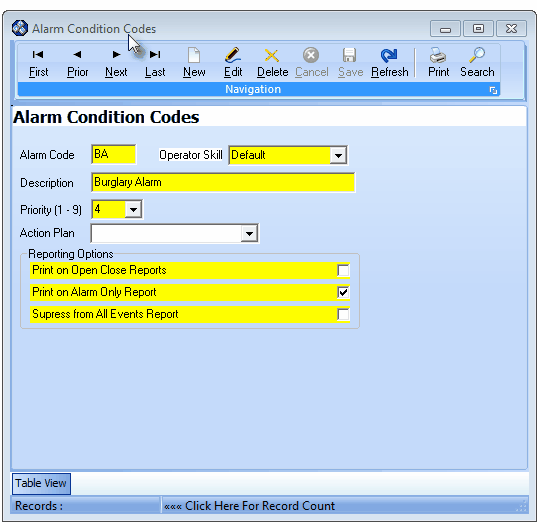
Alarm Condition Codes Form
| • | Subscriber Panel(s) - The Subscriber CSID is entered in the Subscriber Panel(s) section of the Central Station Data Form for each Subscriber to identify each Account that is to be monitored for that Subscriber. |

Subscriber Panel(s) section of the Central Station Data Form
| • | Communicator Format - A Communicator Format must be assigned to the CSID when it is entered in the Subscriber Panel(s) section of the Central Station Data Form for a Subscriber, |
| ▪ | Because each Communicator Format has a set Panel Zones defined, those predefined Panel Zones are automatically connected to the Subscriber Panel(s) section CSID. |
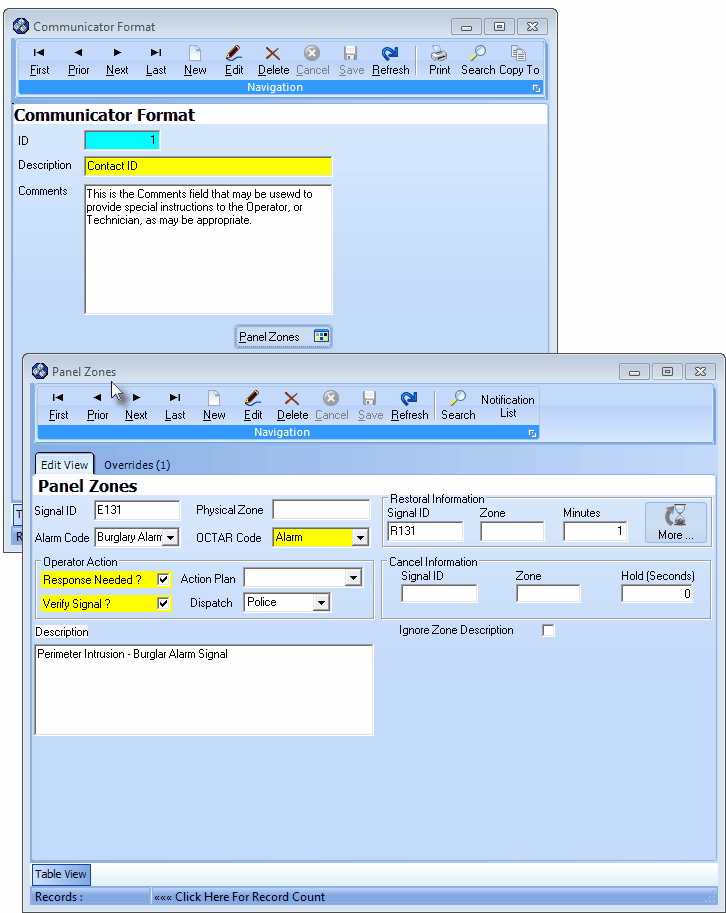
Communicator Format with Panel Zone showing the default steps
| • | Panel Zones - A set of Panel Zones which must be entered for each Communicator Format, identify all of the standard signals that may be transmitted using that Communicator Format, with each of these Panel Zones having a Condition Code assigned. |
| ▪ | If the Panel Zone represents an Active Signal (a Signal requiring an Operator Response), it also contain the default procedures that will be required of the Operator when handling that Active Signal. |
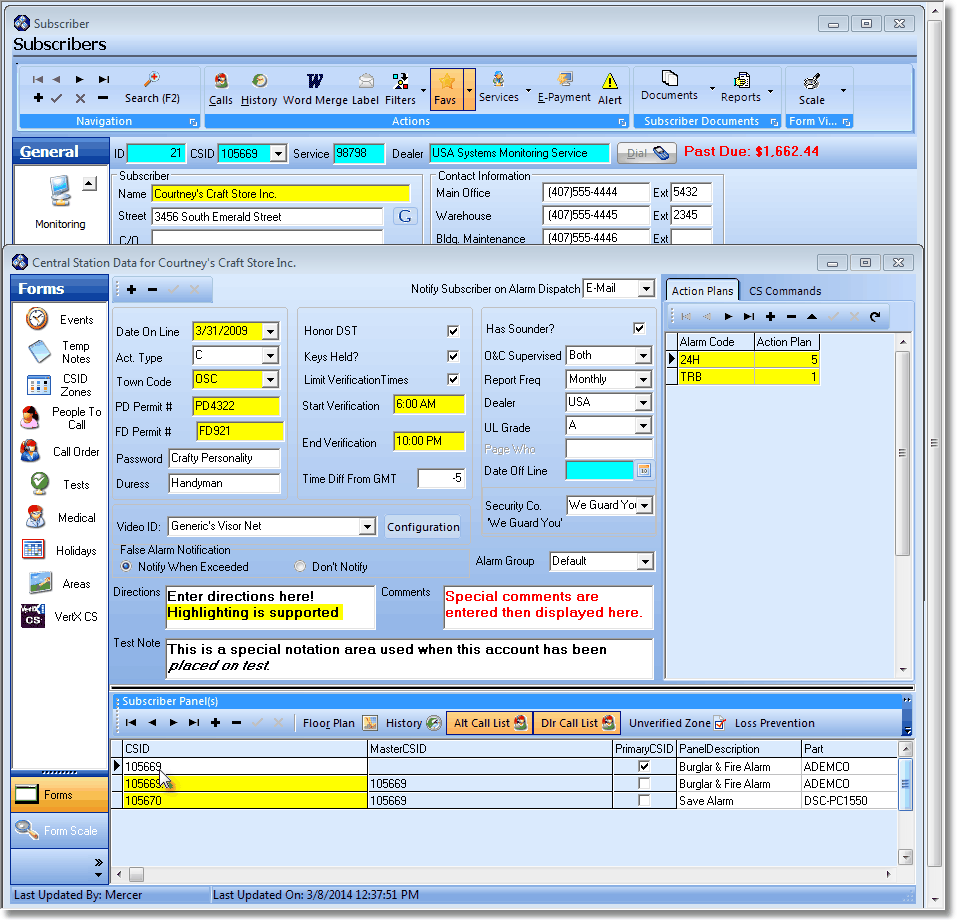
Subscriber Form - Central Station Data Form - CSID entered in the Subscriber Panel(s) section
| • | CSID Zones - Optionally, CSID Zones may be entered when exceptions to the standard handling of certain Alarm Signals are needed to alter the steps for the Verification, Dispatch, and/or Notification Contacts that are defined in Panel Zones. |

CSID Zones Form
| • | CSID Zone Overrides - Exceptions to the handling of CSID Zones, including |
| ▪ | The order in which the People To Call are to be contacted, |
| ▪ | The type of Dispatch required, |
| ▪ | A specially defined Action Plan (see Action Plans below), |
| ▪ | A different Alarm Condition Code, |
| ▪ | And other parameters such as the Day of the Week and/or the Time of the Day that they occur, may be defined using the CSID Zone Overrides tab (see the illustration immediately below). |
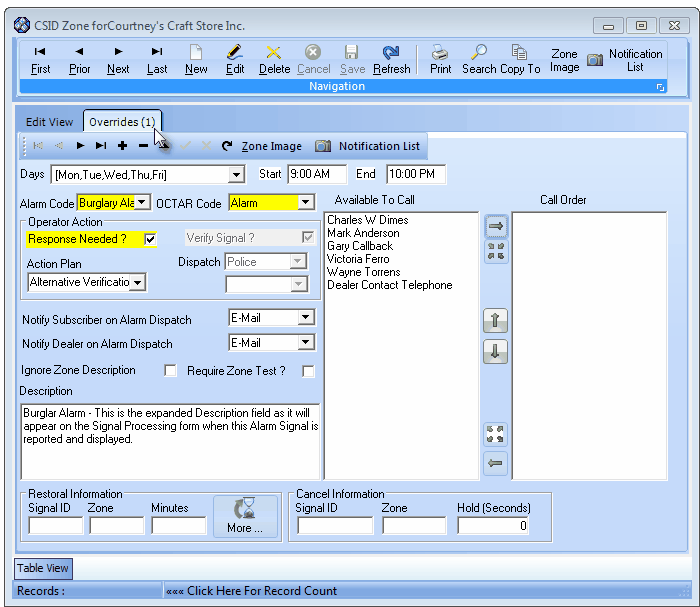
Overrides tab on the CSID Zones Form
| • | Verification Response Codes - As Alarm Signals are handled by an Operator, predefined Verification Response Codes are selected by the Operator when a Verification, Dispatch, or Notification Contact attempt is made (successful or not). |
| ▪ | The selection of that Verification Response Code, provides the additional Operator Guided Response steps - defined in the Actions section - that are required, based on the results of that Contact as were specified in the selected Verification Response. |

Verification Response Form
| □ | Action Plans - This alternative option to the Operator Guided Response allows for the creation of precise, step by step, user defined rules (called Action Steps) that can more finely control the appropriate "next step" resulting from virtually every variable an Operator may encounter while Process Alarms, and also provide an Operator Script which displays for them what to say when one of the Action Plan Steps requires a Verification, Dispatch, or Notification Contact. |
| • | Action Plans are entered in the Action Plans Form, the Action Steps are defined using the Action Plans dialog, and the exact Properties of these Action Steps are created in the Action Plans - Properties Form. |
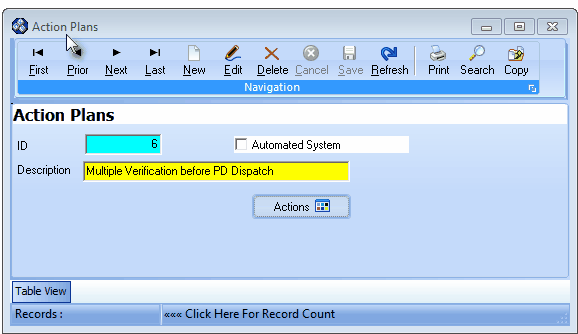
Action Plans Form
| • | Action Plans provide Rules - They enable the Alarm Company to exactly define how selected Alarm Signals for specific Alarm Conditions, CSID Zones, CSID Zone Overrides, Panel Zones, Panel Zone Overrides, and/or Alarm Dealers should be handled by an Operator. |

Alarm Condition Code with optional Action Plan assigned
| • | Action Plans Replace the Operator Guided Responses - When assigned to any of these specific Alarm Conditions, CSID Zones, CSID Zone Overrides, Panel Zones, Panel Zone Overrides and/or Alarm Dealers, they will automatically replace the default Operator Guided Response, associated with the Alarm Signal's normal Operator Guided Responses, substituting the precise rules established within that assigned Action Plan. |

Actions Plan dialog showing the Available Actions list
| • | Action Plans provide Show & Tell for the Operator - In addition, Operator Scripts may be created so, not only can you show the Operator exactly what to do, but also tell the Operator exactly what to say. |
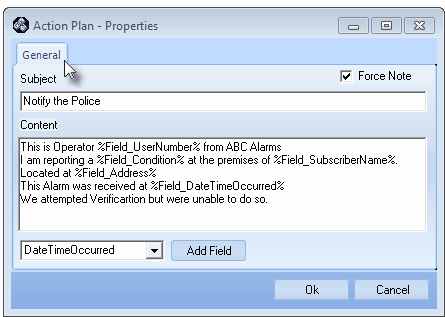
Action Plan - Properties entry
| • | See Action Plan Overview and its related chapters for complete information covering the design, options and usage of Action Plans. |